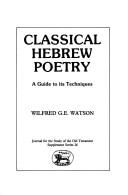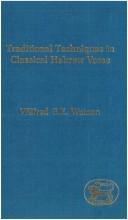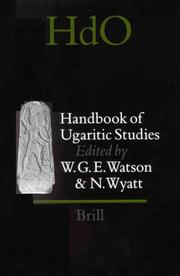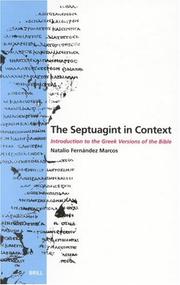| Listing 1 - 10 of 30 | << page >> |
Sort by
|

ISBN: 0905774574 0567540898 9786611802431 1281802433 0567434168 9780905774572 Year: 1984 Volume: 26 Publisher: Sheffield, England : JSOT Press, Dept. of Biblical Studies, University of Sheffield,
Abstract | Keywords | Export | Availability | Bookmark
 Loading...
Loading...Choose an application
- Reference Manager
- EndNote
- RefWorks (Direct export to RefWorks)
In spite of debatable issues, such as metre, we now know enough about classical Hebrew poetry to be able to understand how it was composed. This large-scale manual, rich in detail, exegesis and bibliography, provides guidelines for the analysis and appreciation of Hebrew verse. Topics include oral poetry, metre, parallelism and forms of the strophe and stanza. Sound patterns and imagery are also discussed. A lengthy chapter sets out a whole range of other poetic devices and the book closes with a set of worked examples of Hebrew poetry.
Hebrew poetry, Biblical --- History and criticism --- #gsdb1 --- 223 --- 221.02*1 --- -221.02*1 Oud Testament: bijbelse filologie: hebreeuws --- Oud Testament: bijbelse filologie: hebreeuws --- Poëtische boeken van het Oude Testament --- 221.02*1 Oud Testament: bijbelse filologie: hebreeuws --- Hebrew poetry --- History and criticism. --- Hebrew poetry, Biblical - History and criticism

ISBN: 1281802433 9786611802431 0567434168 9780567434166 1850750483 9781850750482 0905774574 9780905774572 Year: 1986 Publisher: Sheffield JSOT Press
Abstract | Keywords | Export | Availability | Bookmark
 Loading...
Loading...Choose an application
- Reference Manager
- EndNote
- RefWorks (Direct export to RefWorks)
In spite of debatable issues, such as metre, we now know enough about classical Hebrew poetry to be able to understand how it was composed. This large-scale manual, rich in detail, exegesis and bibliography, provides guidelines for the analysis and appreciation of Hebrew verse. Topics include oral poetry, metre, parallelism and forms of the strophe and stanza. Sound patterns and imagery are also discussed. A lengthy chapter sets out a whole range of other poetic devices and the book closes with a set of worked examples of Hebrew poetry. Throughout, other ancient Semitic verse has been used for
Hebrew poetry, Biblical --- Hebrew poetry --- History and criticism. --- 223 --- 221.02*1 --- -Poëtische boeken van het Oude Testament --- Oud Testament: bijbelse filologie: hebreeuws --- History and criticism --- -221.02*1 Oud Testament: bijbelse filologie: hebreeuws --- Poëtische boeken van het Oude Testament --- -History and criticism

ISBN: 1850754594 Year: 1994 Publisher: Sheffield Sheffield academic press
Abstract | Keywords | Export | Availability | Bookmark
 Loading...
Loading...Choose an application
- Reference Manager
- EndNote
- RefWorks (Direct export to RefWorks)
Hebrew poetry, Biblical --- History and criticism --- Bible. --- Terminology.
Book
ISBN: 9789042952140 9042952148 9789042952157 Year: 2024 Publisher: Leuven: Peeters,
Abstract | Keywords | Export | Availability | Bookmark
 Loading...
Loading...Choose an application
- Reference Manager
- EndNote
- RefWorks (Direct export to RefWorks)
The Song of Songs remains one of the most enigmatic and difficult books to understand. In addition, the text has been fluid, as shown by the Qumran scrolls, although it has reached us in a fairly stable form. There are two main focal points in this commentary. One is language, using comparative Semitics as well as reference to more remote cognates in other languages. The Song of Songs contains a very high number of rare Hebrew words and expressions, some of which are unique twists on well-established forms, and these need to be understood before any attempt is made at deciphering the meaning of the book. In many cases there is no clear-cut solution, so the reader is presented with a series of choices. The other focus is on similar compositions from Egypt – its well-known and extensive love poetry – as well as from Anatolia, Mesopotamia, Syria and elsewhere, which supply an invaluable cultural background. Particular attention is paid to poetic aspects, including comparison with ancient Near Eastern verse patterns. In line with the rest of the series, account is also taken of the many approaches adopted by previous interpreters. The illustrations, black and white versions of original watercolours, help to give this commentary a contemporary appeal.
Article
Year: 2000
Abstract | Keywords | Export | Availability | Bookmark
 Loading...
Loading...Choose an application
- Reference Manager
- EndNote
- RefWorks (Direct export to RefWorks)
Article
Abstract | Keywords | Export | Availability | Bookmark
 Loading...
Loading...Choose an application
- Reference Manager
- EndNote
- RefWorks (Direct export to RefWorks)
Article
Year: 2002
Abstract | Keywords | Export | Availability | Bookmark
 Loading...
Loading...Choose an application
- Reference Manager
- EndNote
- RefWorks (Direct export to RefWorks)
Article
Year: 2000
Abstract | Keywords | Export | Availability | Bookmark
 Loading...
Loading...Choose an application
- Reference Manager
- EndNote
- RefWorks (Direct export to RefWorks)

ISSN: 01699423 01699423 ISBN: 9004109889 9004294104 9789004109889 Year: 1999 Volume: 39 Publisher: Leiden Brill
Abstract | Keywords | Export | Availability | Bookmark
 Loading...
Loading...Choose an application
- Reference Manager
- EndNote
- RefWorks (Direct export to RefWorks)
Over the past seven decades, the scores of publications on Ugarit in Northern Syria (15th to 11th centuries BCE) are so scattered that a good overall view of the subject is virtually impossible. Wilfred Watson and Nicolas Wyatt, the editors of the present Handbook in the series Handbook of Oriental Studies, have brought together and made accessible this accumulated knowledge on the archives from Ugarit, called 'the foremost literary discovery of the twentieth century' by Cyrus Gordon. In 16 chapters a careful selection of specialists in the field deal with all important aspects of Ugarit, such as the discovery and decipherment of a previously unknown script (alphabetic cuneiform) used to write both the local language (Ugaritic) and Hurrian and its grammar, vocabulary and style; documents in other languages (including Akkadian and Hittite), as well as the literature and letters, culture, economy, social life, religion, history and iconography of the ancient kingdom of Ugarit. A chapter on computer analysis of these documents concludes the work. This first such wide-ranging survey, which includes recent scholarship, an extensive up-to-date bibliography, illustrations and maps, will be of particular use to those studying the history, religion, cultures and languages of the ancient Near East, and also of the Bible and to all those interested in the background to Greek and Phoenician cultures.
Cuneiform inscriptions, Ugaritic --- Ugaritic philology --- Inscriptions cunéiformes ougaritiques --- Philologie ougaritique --- Ugarit (Extinct city) --- Ougarit (Ville ancienne) --- Cuneiform inscriptions, Ugaritic. --- Ugaritic philology. --- 809.25 --- 939.43 --- Ugaritic cuneiform inscriptions --- Ugaritisch --- History Ancient world Syria to 640 --- Ougarit (Extinct city) --- Raʼs Shamrah (Syria) --- Ras Shamra (Syria) --- Ugarit (Ancient city) --- Syria --- Antiquities --- 809.25 Ugaritisch --- Inscriptions cunéiformes ougaritiques

ISBN: 9004115749 9004498087 Year: 2000 Publisher: Leiden Brill
Abstract | Keywords | Export | Availability | Bookmark
 Loading...
Loading...Choose an application
- Reference Manager
- EndNote
- RefWorks (Direct export to RefWorks)
| Listing 1 - 10 of 30 | << page >> |
Sort by
|

 Search
Search Feedback
Feedback About UniCat
About UniCat  Help
Help News
News